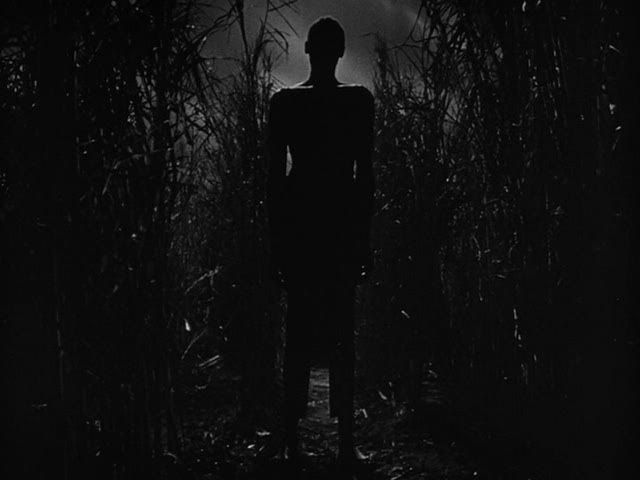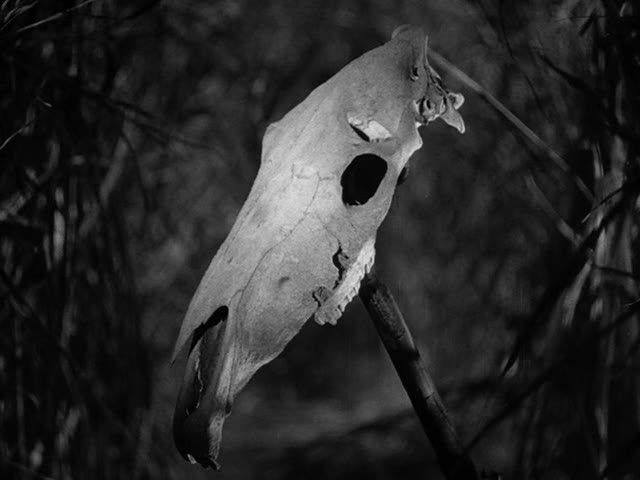
The wind blowing through palm fronds on dark, moody Caribbean nights. The insistent rhythm of tribal drums beating in the distance. The strange moans and calls that echo through the chilly night air. With such simple effects, director Jacques Tourneur and legendary horror producer Val Lewton conjured up a genuinely eerie, haunting atmosphere for a film that has only a tangential relationship to its own campy title, I Walked With a Zombie. As usual for Lewton productions, the title came first, suggesting a lurid B-movie shocker, but instead Lewton and his team crafted a subtle, creepy, and emotionally complex romance set on the island of St. Sebastian. When the young, earnest nurse Betsy (Frances Dee) arrives on the island to care for the ailing Jessica (Christine Gordon), she finds herself unexpectedly in the middle of a love triangle between Jessica, her husband Paul Holland (Tom Conway), and his half-brother Wesley (James Ellison). There's a mysterious past here, a suggestion of betrayal and illicit love that immediately preceded Jessica's sudden descent into a near-comatose condition. The film doesn't so much tell a story as suggest one, obliquely tracing the contours of a tale that mostly resides in the past, its most important scenes already played out and inaccessible. This should necessitate a great deal of exposition, but except for a too-tidy resolution of one mystery towards the end of the film, the script is circumspect and allusive. By the end of the film, the audience knows more or less what happened without having been directly told, and without having the essential mystery of the story dissipated.
This sense of mystery is created almost entirely with Tourneur's subtle atmospheric effects. The wind is practically a character in the film, the breeze rustling through the trees and creating an uneasy aura that lingers over everything. When Betsy first arrives on the island, she's woken in the night by cries from somewhere within the Holland compound, and she goes out into the darkness to explore. The mood is set by the elegant use of shadow — all the windows in this house seem to have slats, the better to create those distinctive noir patterned shadows — and the whispering of the wind, the swaying of the palms and the way Betsy's nightgown billows gently around her legs as she walks across the cobbled garden path. There's a poetic eye for detail in these scenes, and the film aims to create an eerie, creeping terror rather than going for sudden shocks or horrifying images. One gets the sense that Tourneur is going for horror as crafted by Poe, where an accumulation of small details, insignificant in themselves, combine into an image of the macabre. The film's lighting and the stalking motion of the camera, circling around Betsy like a jungle creature around its prey, turn the island mansion into a haunted house, complete with a winding stone staircase in a shadowy tower.

As the film progresses, Betsy inexplicably falls in love with Paul, and then begins to learn more about the island's voodoo traditions, eventually coming to suspect that Jessica can be cured by a voodoo ceremony where medicine has failed. Betsy leads the sleepwalking Jessica through the sugar cane fields, past a tall, skeletal zombie guard, to a clearing where voodoo priests and priestesses dance and chant. This is a masterpiece of atmospheric horror, with not a word uttered throughout the whole trek, and no sound except the beat of the drums, the moaning song, and the whistle of the wind through the fields and treetops. Along the way, the two women come across many signs of the voodoo cult, scattered across the path like markers or warnings: a cow's skull on a stick, the hanged corpse of an animal, a gourd with holes cut into it so that the wind blows a mournful song through its hollowed body, a shattered human skull laid in the center of a circle of bones. Finally, they come across the zombie guard Carrefour (Darby Jones), whose wide, staring eyes and gaunt face represent the film's only overt suggestion of supernatural powers at work. Even here, rather than using this grim visage and imposing form for shocks, Tourneur instead lingers on the image, emphasizing the towering shadow of the zombie amidst the stalks of sugar cane, or letting the light of a flashlight play across his exaggerated features.
Throughout I Walked With a Zombie, potent images like this drive the story without explaining anything too directly. The closest the film comes to proper exposition is in the form of an island singer (the calypso star Sir Lancelot) whose song about the Holland family fills in some of the background on Paul, Wesley, and Jessica. But this material is not used lazily, and Tourneur films Betsy listening to this song as the singer advances from the shadows, strangely threatening despite his lilting voice, his words seeming to portend danger to come for the young nurse. It's a haunting scene, and a perfect example of the ways in which Tourneur and Lewton could transform genre conventions — like the necessary exposition of the love triangle that preceded Jessica's coma — into a new, strange poetry.

4 comments:
Great post, Ed. I love your comments about the wind - I felt the same way about it. Every time I see this film or read about it, I think a little more highly of it. It's really fantastic.
"The film doesn't so much tell a story as suggest one, obliquely tracing the contours of a tale that mostly resides in the past, its most important scenes already played out and inaccessible."
A perfect expression of one of the most appealing (and overlooked) qualities of a great movie. There's always more than meets the eye, the hidden half so to speak, which enriches what you do see.
Bit of a question! Why is an anglophonic island the beneficiary of Haitian Creole. "Papa Legba", "Carrefour", ?
Left out is Lewton/Tourneur's avoidance of racist blackspeak. From the interchanges with servants and especially with Sir Lancelot Calypso lyrics there is an avoidance of stereotypes. There also is a knowledge of Vaudou basics. Carrefour is where the ceremonies lie. Damballa is a major Vaudou deity and so is Papa Legba. Why situate th whole megillah on an Anglophonic Island? The chants are in Creole not Anglo!
Post a Comment